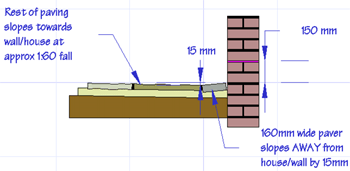Page 1 of 1
Posted: Fri May 10, 2002 7:49 pm
by DAVE YEARSLEY
Hello Tony, greetings from sunny Rochdale.
I hope you or anybody can help.
I am now ready to lay my Marshall’s Heritage paving. I have calculated how much grit sand and cement I need to bed down, fluff the top up and lay the flags.
The problem is, according to the Marshall’s technical info at the back of the catalogue, due to the manufacturing process of Heritage flags they should not be laid on sand, but laid either on 5 dabs of mortar or a full bed of mortar.
Now, do I follow the manufacturer recommendations or get in touch with them to see if they require any oats for their horses?
I would be grateful for any comments.
Regards
Dave Yearsley
Posted: Fri May 10, 2002 8:44 pm
by 84-1093879891
If you make your bedding as a 10:1 mix of the grit sand and cement, that will do.
The spot bedding method that Marshalls insist on illustrating, both on their site and in their latest arty-farty-can't-see-the-bloody-flags catalogue is aimed at the amateurs and is their marketing depts' attempt to make flagging seem easy.
Spot Bedding is a bad thing for any and all the reasons listed on the Flagging page. The use of a 10:1 semi-dry bedding is the equivalent of a full mortar bed.
Quite why Marshalls suggest Heritage can't be successfully laid on unbound grit sand has not been explained to me, but I have a simple arrangement with Marshalls - I won't tell them how to manufacture flags, kerbs and block pavers as long as they don't tell me how to lay them. ;)
Hope the weather holds out for you, Dave. I saw the sun shine in Rochdale once - 1973 it was, when my dad did the 'road and sewers' for a housing estate in Syke. ;)
Posted: Sat May 11, 2002 12:19 pm
by DAVE YEARSLEY
Thanks for the advise.
As you stated Marshals make great flags, therefore you make a great flagger and more.
No doubt I'll be asking more advise soon. Great site and very helpful.
Dave
Posted: Fri May 17, 2002 7:55 pm
by DAVE YEARSLEY
Ive just ordered my Marshalls Heritage for the 30th May,
the patio area is dug out and I'm just looking at the levels. The main area to be flagged is 9mtrs long x 3mtrs wide, the 3mtrs is between the house wall and a retaining garden wall, there is a gully against the house wall in the middle of the 9mtrs. What is the best way to mark out my levels, chalk line against the walls or timber battens?
I am thinking of making the fall towards the gully from both ends of the 9 mtrs inwards and towards the gully from the retaining wall.I hope this makes some sort of sense and any advise will be appreciated.
P.S the sun is still shining here in Rochdale.
Thanks
Dave Yearsley
Posted: Fri May 17, 2002 9:08 pm
by DAVE YEARSLEY
P.s. to above:
The levels I require are to lay my grit sand.
Thanks
Dave
Posted: Sat May 18, 2002 3:48 pm
by 84-1093879891
I
really don't like surface water lodging against brickwork, even on its way to a gully, so this is my usual solution for patios using riven paving. Against the wall, lay a single course of a tumbled block, something like Drivesett by Marshalls or Woburn by Charcon, and slope it AWAY from the wall by about 15mm for a 160mm wide block, or 1:10 if you're using summat else. I like to lay this edge course on a cement bound bed, something like 10:1 grit sand with cement or a lean-mix concrete, so that it doesn't get easily dislodged when the rest of the paving work is done, and also, to ensure it stays put over the longer term.

Once this course is in place, the rest of the paving can be laid falling TOWARDS the house or the wall. This creates a low channel 160mm (in this example) away from the wall. Obviously, this 'channel' needs some end fall to direct the surface water to a collection point, such as a linear drain or a gully. End fall can be created by laying the entire course to the required fall, around 1:60, or by creating 'twist' in the course next to the wall. This is something that really needs a 3D drawing or a photo to explain, but for your patio, Dave, I'd just lay the entire course with endfall, from the outer edges to the central gully. Assuming the gully is central, then you;ve 4.5m to either side, so you need around 75mm of end fall, and 50mm of cross fall for the 3m width.
If you don't fancy the paver edge course, you can create the same effect by laying a 300mm wide cours e of the Heritage against the wall, giving each 300mm wide flag 20-30mm of fall AWAY from the wall, and then carrying on as outlined above.
Finally, a chalkline is by far the best way to mark your levels. Fixing timber battens is time-consuming and a waste of good timber. Use the chalkline or even a string line, and check your work with a spirit level as you progress.
Are you going to take any photos of this job, Dave? I'd like to see the end product and/or some 'under construction' piccies. :)
